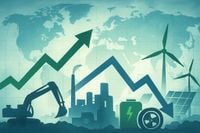As 2025 draws to a close, the world’s industrial metals market is experiencing a dramatic transformation, with Europe and Australia emerging as pivotal players in a global contest shaped by resource nationalism, decarbonization, and mounting geopolitical tension. The European Union (EU), determined to fortify its supply chains and reduce its reliance on China, is doubling down on strategic partnerships with Australia to secure access to critical raw materials—those essential elements that power everything from electric vehicles to renewable energy infrastructure and digital networks.
According to recent statements by EU Commission Vice-President Maroš Šefčovič, the bloc is shifting away from traditional, market-driven trade models. Instead, it’s embracing a more hands-on approach: investing directly in Australian mining projects, forging long-term supply agreements, and even considering joint infrastructure ventures. As Šefčovič put it, the EU’s new focus is about “targeted capital commitments and binding supply agreements” to ensure European industries aren’t left scrambling for vital inputs if global tensions flare up, as reported by multiple European outlets.
The urgency behind this pivot is rooted in hard-learned lessons. Just a few years ago, Europe’s heavy dependence on Russian oil and gas forced a costly and chaotic reshuffling of energy supplies after the war in Ukraine and ensuing sanctions. Now, as China—long the world’s dominant producer of rare earths and other critical minerals—wields export restrictions as leverage in its trade disputes with the United States, European leaders are determined not to repeat those mistakes. The EU’s challenge is clear: avoid being caught flat-footed by sudden supply shocks in sectors as varied as semiconductors, batteries, and defense.
Australia’s appeal as a partner is obvious. The country boasts vast reserves of lithium, rare earths, and other strategic minerals, all underpinned by a stable political system and a growing ambition to become a global supplier of these essential resources. The European Investment Bank (EIB) has already signaled its intent to deepen ties, agreeing to ramp up financing for Australian mining and processing projects. Such investments could see European firms take equity stakes in mines, secure long-term off-take agreements, or co-finance new processing facilities—moves designed to lock in supply and shield European industries from future disruptions.
For Brussels, the stakes go beyond mere economics. Critical raw materials aren’t just commodities; they’re the lifeblood of the green transition. Without a steady flow of these inputs, the EU’s goals for electromobility, renewable energy, and digital infrastructure could falter. As Šefčovič pointedly recalled, “Europe does not want to find itself in a situation again where it has to organize costly replacement solutions within a very short time.” The continent’s industrial future, he argues, depends on limiting new dependencies before they become crises.
In this strategic realignment, Japan’s long-term approach serves as a blueprint. For years, Tokyo has invested in overseas mines and refineries, ensuring its industries remain supplied even in turbulent times. The EU now aims to replicate this model, moving from passive market participant to active investor and partner along the raw materials value chain.
This new direction also breathes life into the stalled EU-Australia free trade agreement. Talks broke down in 2023 over agricultural access, but with both sides now recognizing the mutual benefits of closer cooperation—especially in the face of China’s growing influence—negotiations are expected to resume early in 2026. A successful deal could slash tariffs, strengthen investment protections, and create a clearer framework for long-term raw material partnerships, making it easier for European capital to flow into Australian projects and for Australian minerals to enter the EU market. Political signals from both Canberra and Brussels suggest a renewed sense of urgency and strategic alignment.
This European-Australian partnership is unfolding against a backdrop of profound change in the global industrial metals market. As reported by Market Minute and other financial analysts, the sector—excluding copper—is experiencing a period of divergence and volatility. Some metals, like aluminum, are set to move from surplus to deficit in 2025, thanks in part to capacity constraints in China and robust demand from the renewable energy and electric vehicle sectors. Aluminum prices have been buoyed by US tariffs and the recovery in global demand, with projections of a 400,000 to 600,000 metric ton deficit next year.
Not all metals share this bullish outlook. Nickel, for example, faces a steep surplus of nearly 200,000 tonnes in 2025, a result of soaring Indonesian production and softer-than-expected demand from the EV battery sector. Prices have slumped to around $15,000-$16,000 per ton, and major producers like BHP have responded by suspending operations and tightening costs. Zinc and lead are also grappling with oversupply—148,000 tonnes and 121,000 tonnes respectively—with weak construction demand and new mine openings (such as the Kipushi mine in the Democratic Republic of Congo) weighing on prices. Tin, on the other hand, remains volatile but supported by supply squeezes and strong demand from the semiconductor and AI infrastructure sectors, with prices hovering near $32,000 per ton.
Iron ore, the backbone of steelmaking, is under pressure as well. China’s property sector woes have dragged down steel demand, keeping iron ore prices in the $95-$100 per tonne range. Even as major miners like BHP, Fortescue, Vale, and Rio Tinto maintain strong output and prepare for new projects like Simandou in West Africa, the long-term outlook remains bearish.
These market dynamics are not happening in a vacuum. The push for decarbonization, the rise of resource nationalism, and the fracturing of global trade into regional blocs are all reshaping the landscape. The old model of hyper-efficient, globalized supply chains is giving way to security-oriented regional systems, as countries scramble to lock in access to critical materials. The United States, for example, has doubled down on tariffs—raising duties on imported steel and aluminum to as much as 50%—while the EU’s Carbon Border Adjustment Mechanism is incentivizing local, low-emission production. These measures, while designed to boost domestic industries and secure supply chains, have triggered retaliatory actions and further complicated global trade flows.
For companies and investors, the stakes are high. Aluminum producers like Alcoa, Rio Tinto, and Century Aluminum stand to benefit from tighter markets and higher prices, while nickel and zinc miners face tough choices about cost control and project deferrals. Diversified giants like Glencore and BHP may weather the storm thanks to their broader portfolios, but the pressure to adapt—through efficiency, recycling, and ESG integration—is relentless. Meanwhile, industries from automotive to consumer goods must navigate heightened volatility and supply chain risk, with many turning to reshoring and regional partnerships to hedge against geopolitical shocks.
Looking ahead, the long-term forces of the energy transition and AI-driven demand for metals are expected to drive a new era of investment and innovation. Clean energy technologies could account for the majority of demand for nickel, cobalt, and lithium by 2040, pushing prices for these “energy transition metals” to historic highs. The challenge, however, will be balancing the need for secure, responsible sourcing with the economic realities of volatile markets and shifting trade policies.
In this transformative moment, the EU’s deepening partnership with Australia stands as a microcosm of the broader global scramble for resource security. As governments and companies alike navigate the cross-currents of decarbonization, protectionism, and technological change, the race for critical raw materials is set to define the next chapter of industrial policy—and the future of global trade itself.




